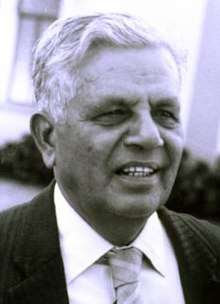| Shikaripura Ranganatha Rao | |
|---|---|
 | |
| Born | Shikaripura Ranganatha Rao (1922-07-01)1 July 1922 Anandapuram, Sagar taluk, Shimoga district, erstwhile Mysore State (now Karnataka) |
| Died | 3 January 2013(2013-01-03) (aged 90) |
| Nationality | Indian |
| Occupation | Archaeologist |
Shikaripura Ranganatha Rao (1 July 1922 – 3 January 2013), commonly known as Dr. S. R. Rao, was an Indian archaeologist who led teams credited with discoveries of a number of Harappan sites, including the port city Lothal and Bet Dwarka in Gujarat.
Biography and career
Rao was born into a Brahmanical religion family on 1 July 1922. He completed his education from Mysore University.
Indus script decipherment
While mainstream scholarship is generally in agreement with Rao's approach of comparison, the details of his decipherment have not been accepted, and the script is still generally considered undeciphered. John E. Mitchiner, after dismissing some more fanciful attempts at decipherment, mentions that "a more soundly-based but still greatly subjective and unconvincing attempt to discern an Indo-European basis in the script has been that of Rao".
In a 2002 interview with The Hindu, Rao asserted his faith in his decipherment, saying that "Recently we have confirmed that it is definitely an Indo-Aryan language and deciphered. Prof. W. W. De Grummond of Florida State University has written in his article that I have already deciphered it."
Identification of Dwarka
At Kushasthali (Bet Dwarka), a strip of sand and stone situated 30 km (19 mi) north of town of Dwarka, Rao and his team found a wall (560 metres long) visible on the shore itself. Dating of pottery found here gave a date of 1528 BCE based on thermoluminescence dating.
Rao asserts that the unearthed remains at Dwarka were the historical city that was home to Krishna, believed to be the eighth Avatar of Vishnu. it is important to note that the remains found in the ocean are not confirmed to be from Dwarka; they could belong to any other ancient city as well.
Publications
- Lothal and the Indus Civilisation, Bombay: Asia Publishing House, ISBN 0-210-22278-6 (1973)
- Lothal: A Harappan Port Town (1955 - 1962), Vols. I and II, Memoirs of the Archaeological Survey of India, no.78, New Delhi, ASIN: B0006E4EAC (1979 and 1985)
- Lothal, New Delhi: the Director General, Archaeological Survey of India (1985)
- Dawn and Devolution of the Indus Civilization, ISBN 81-85179-74-3, Delhi: Aditya Prakashan (1991)
- New Trends in Indian Art and Archaeology: S.R. Rao's 70th Birthday Felicitation Volumes, edited by B.U. Nayak and N.C. Ghosh, 2 vols. (1992)
- New Frontiers of Archaeology, Bombay: Popular Prakashan, ISBN 81-7154-689-7 (1994)
- The Lost City of Dvaraka, National Institute of Oceanography, ISBN 81-86471-48-0 (1999)
- Marine Archaeology in India, Delhi: Publications Division, ISBN 81-230-0785-X (2001)
References
- Baiderbettu Upendra Nayak; N. C. Ghosh (1992). New Trends in Indian Art and Archaeology S.R. Rao's 70th Birthday Felicitation Volume · Volume 1. Aditya Prakashan. p. XXI. ISBN 978-81-85689-12-8.
Shikaripur Ranganatha Rao (S. R. Rao) was born on 1st July, 1920 at Anandapuram in Sagar taluk of Shimoga district in the erstwhile Mysore (now Karnataka) state. His father Shikaripur Hucha Rao, a Madhwa Brahmin, was well educated upto first year in Arts and wanted...
- John E. Mitchiner (1978), Studies in the Indus Valley Inscriptions, Oxford & IBH, p. 5
- Rao refers to a statement by W. W. De Grummond, of the Department of Classics, Florida State University, that "Dr. Rao's decipherment of the Indus script has met with considerable acceptance and will serve now as a basis for further and continuing study of the language of the ancient Indus Valley civilization." in "Linguistic Affinities of Old Indo-Aryan with Classical Greek and Latin", B.U. Nayak, N.C. Ghosh (eds.) New Trends in Indian Art and Archaeology: S.R. Rao's 70th birthday felicitation volume, Aditya Prakashan (1992), pp. 133-139. ISBN 81-85689-12-1
- ^ S.R.Rao, The Lost City of Dvaraka. National Institute of Oceanography 1999
- Vora, K. H.; Gaur, A. S.; Price, David; Sundaresh (2002). "Cultural sequence of Bet Dwarka island based on thermoluminescence dating". Current Science. 82 (11): 1351–1356. ISSN 0011-3891.
External links
- Interview with S. R. Rao at The Hindu
- Dr. Rao emphasizes preservation of heritage sites in India
- Indus script
- Hindu dated 20 Feb 2006 - S. R. Rao among Vidya Varenya awardees
- Google's cache of Sundeep Books biographic write-up at archive.today (archived 9 May 2007)
- Rao biography
- Interview
- Portrait of S.R.Rao at Kamat.com
- S.R.Rao's speech(mp3)about Lord Krishna's Dwarka at DeshGujarat.Com